PON: "The last mile"? I will do this

You may not know what a "PON" (often pronounced "fat") is, but you must have heard of "fiber to the home".
You may not know what an "ONU" is (usually pronounced "oh um excellent"), but when you open the weak current box in your home, you must see a "little box" that connects to the optical fiber.
This "small box" is ONU (Optical Network Unit, optical network unit), commonly known as "optical cat".
Today's protagonist - "PON" (Passive Optical Network, passive optical network), is the key to realizing fiber-to-the-home, and is the "last mile" optical fiber transmission technology between the network and the user.

What is PON
The optical fiber of each household is connected to a huge network behind it. Let us trace the source of the optical fiber and explore it together.
The optical fiber connecting the optical cat comes from the optical splitter in the weak current well, which can divide one optical signal into multiple channels in a certain proportion. The optical signal entering the optical splitter comes from an optical line terminal OLT (Optical Line Terminal).
The OLT, the ONU and the "transmission channel" ODN (Optical Distribution Network, optical distribution network) between the two constitute a PON network. in:
- The OLT is an operator-side device, responsible for allocating upper-layer service network data to users.
- The ONU is a user-side device that is responsible for receiving data sent by the OLT and directly providing services to users.
We can briefly understand the architecture of the PON network according to the following figure.
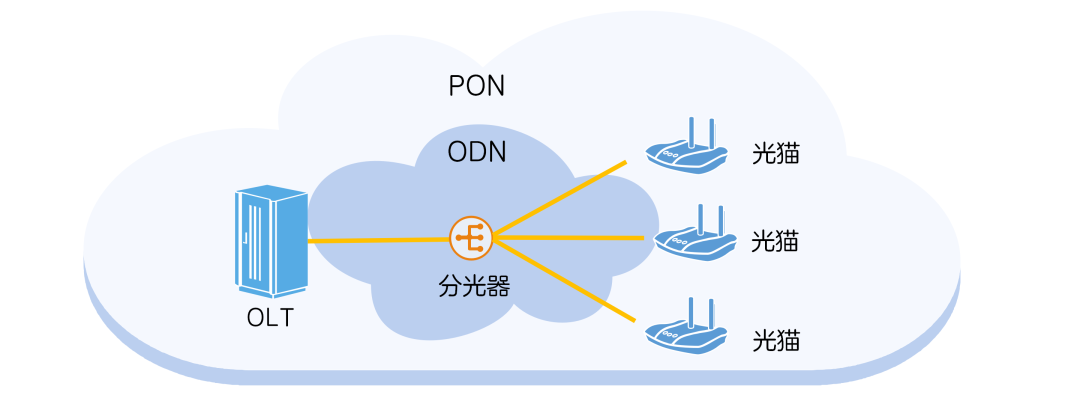
PON core technology
If the PON network is regarded as a company, then the OLT is equivalent to the headquarters, the ONU is equivalent to the local offices, and the optical splitter is equivalent to the station. Let's first look at the three core technologies of PON - encryption, ranging and dynamic bandwidth allocation.
(1) Encryption
The headquarters OLT needs to transmit a large amount of information to the ONUs in various offices, but the information between different offices needs to be kept confidential. In addition, spies (rogue ONUs) are often encountered on the road to sabotage. To ensure that information is not leaked, the OLT will regularly negotiate different keys with the ONU to ensure information security.
(2) Ranging
Jurisdictions are divided across the country, and each jurisdiction has several offices and stations (optical splitters). The routes from the ONU to the post station in each office are different, and the time it takes is different. In order to avoid unnecessary conflicts between the clerks of each office and the collision at the post station, it is necessary to understand these routes in advance. Therefore, the headquarters OLT will start the ranging function when the ONU registers for the first time, calculate the physical distance of each ONU, and specify appropriate equalization delay parameters according to the physical distance of the ONU.
(3) Dynamic bandwidth allocation
In order to better manage and guide the work of the office, the headquarters OLT needs to collect the information reported by the ONU of the office in a timely manner, and the more the better. In other words, local offices need sufficient time to report without wasting time. However, the information reported by ONUs in local offices is often more or less frequently in combination with local conditions, and the importance is different. Therefore, the headquarters OLT will dynamically adjust their reporting time and reporting order according to the specific conditions of each location.
Based on the three core technologies, in the process of development and evolution of PON, technologies such as EPON, GPON, 10G-EPON and XG(S) PON have been produced.


 two families
two families 
In the process of evolution, PON technology has been divided into two major families - EPON (Ethernet PON) and GPON (Gigabit-capable PON), which are organized by two different organizations ITU-T (International Telecommunication Union Telecommunications Standards Branch) and IEEE ( Institute of Electrical and Electronics Engineers).
The difference between EPON and GPON is mainly in the data link layer, that is, the way of data encapsulation into frames is different.
- EPON adopts the Ethernet encapsulation method and is suitable for Ethernet services.
- GPON adopts GEM (GPON Encapsulation Mode, GPON encapsulation mode) encapsulation method, the technology is relatively complex, and can carry more types of services, including Ethernet services, ATM (Asynchronous Transfer Mode, Asynchronous Transfer Mode) services and TDM (Time-division multiplexing) , time division multiplexing) service.
GPON has higher bandwidth and wider coverage than EPON, but it is also more complex and costly to implement.

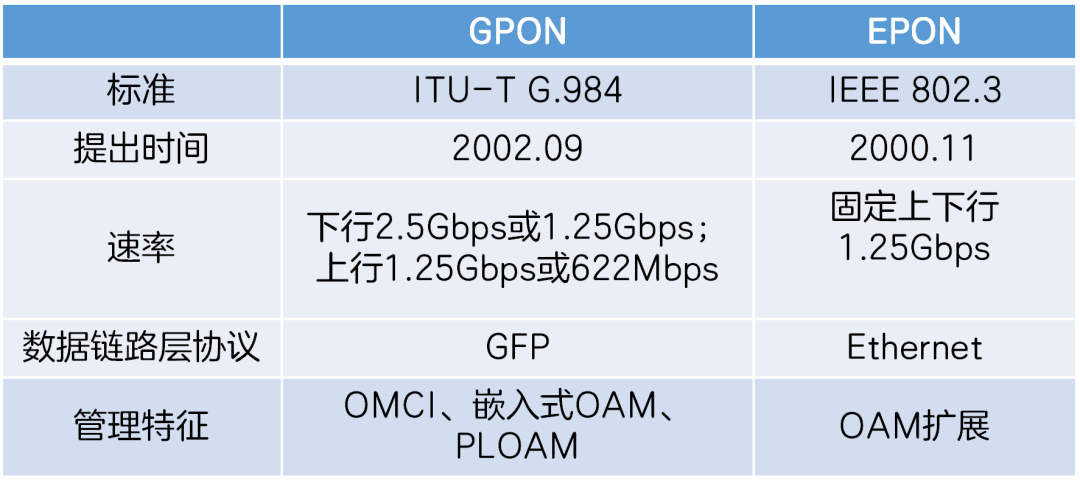
Traditional EPON and GPON technologies can provide users with a speed of 100M. However, with the surge of big video and cloud services such as 4K/8K and AR/VR, people urgently need more advanced PON technology.
EPON and GPON have also begun to upgrade their technologies, and 10G-EPON and XG(S) GPON have gradually replaced EPON and GPON, ushering in the era of gigabit fiber.
EPON→10G-EPON
Let's start with the EPON family.
10G-EPON perfectly inherits the working mechanism of EPON:
- The OLT sends Ethernet data to the ONU in broadcast mode, initiates and controls the ranging process, and records the ranging information. Allocate bandwidth for the ONU, control the start time and window size of the ONU sending data, and manage the ONU through the OAM (Operation Administration and Maintenance, operation and maintenance management) protocol.
- The ONU chooses to receive the broadcast data sent by the OLT, responds to the ranging command sent by the OLT, buffers the user data, and sends data to the upstream direction in the sending window allocated by the OLT.
10G-EPON uses the EPON protocol to the maximum extent to meet the high bandwidth requirements of users, and supports voice, video, Ethernet and other services. Its inheritance is mainly reflected in two aspects.
- Expand the upstream and downstream bandwidth of the EPON standard, with a rate of 10Gbps. 10G-EPON supports two modes: symmetrical and asymmetrical. The symmetrical mode means that the upstream and downstream bandwidths are the same. In actual use, choose one of the two to meet the bearing needs of different customers.
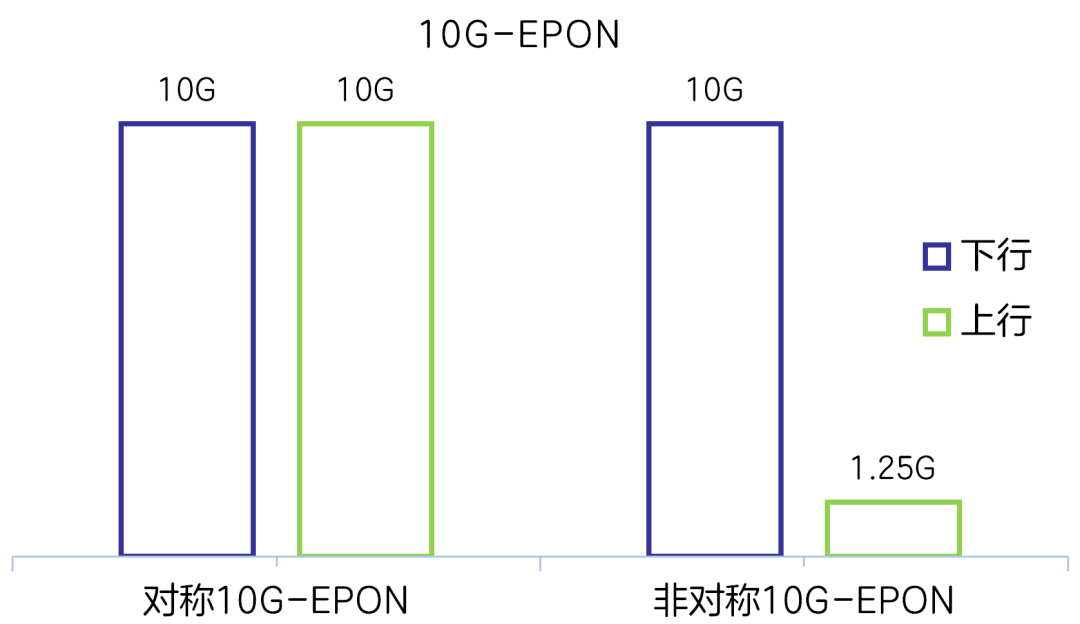
- With super compatibility, 10G-EPON ONU and EPON ONU can coexist in an optical distribution network.
10G-EPON downstream wavelength is independent, using broadcast mode to send information, ONUs take what they need; upstream wavelengths overlap, using TDMA (Time division multiple access, time division multiple access) mode to realize the coexistence of EPON ONU and 10G EPON ONU, support EPON to 10G -EPON smooth evolution.
Use a table to simply compare EPON and 10G-EPON.

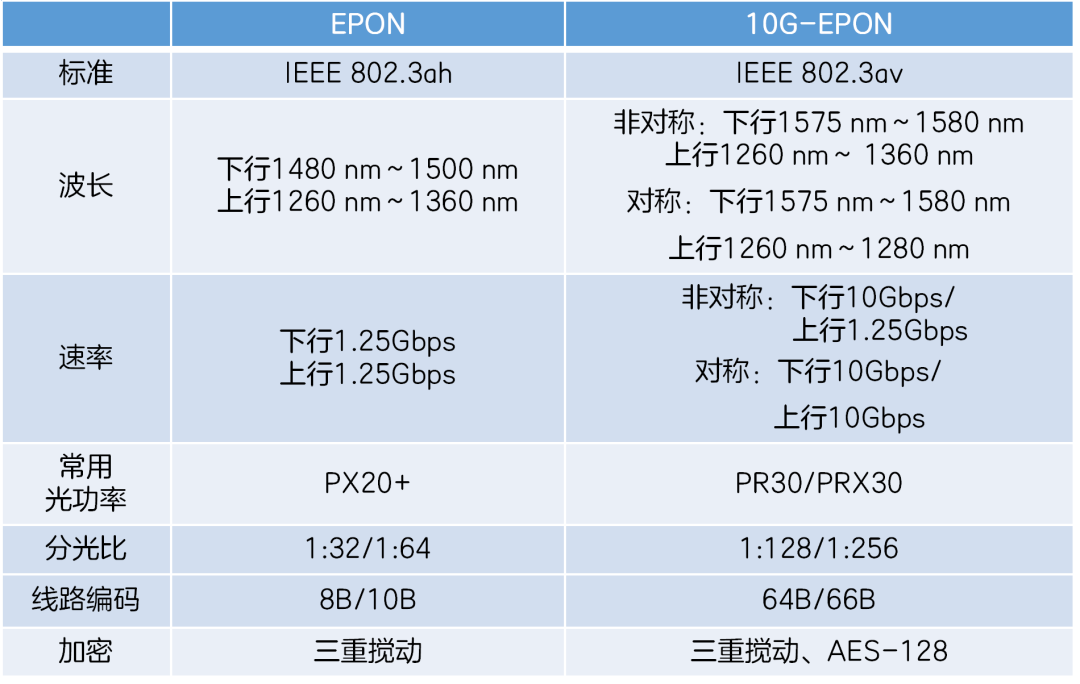
GPON→XG(S)-GPON
Let's look at the GPON family again.
XG(S)-PON includes XGS-PON and XG-PON, which are a pair of brothers.
- Symmetrical XGS-PON, supporting 10G upstream and downstream, to meet the needs of undertaking symmetrical services such as government, enterprise, and base station bearer.
- Asymmetric XG-PON, supporting 2.5G/10G upstream and downstream, to meet the needs of asymmetric services based on home broadband.
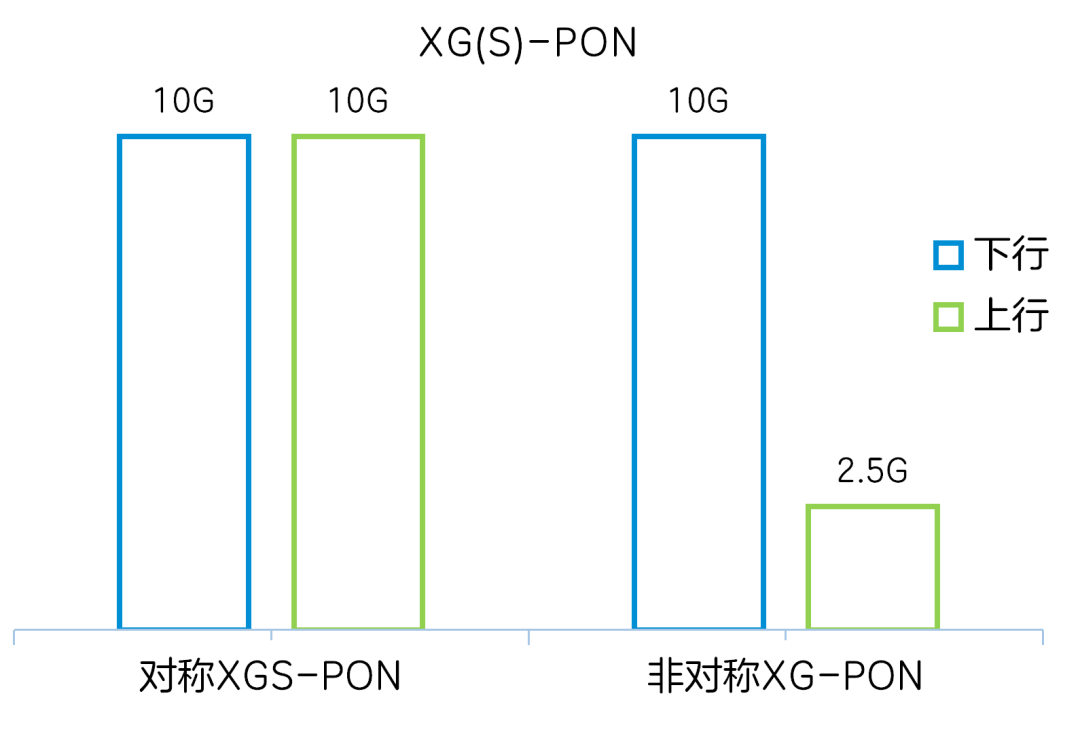
 Symmetrical XGS-PON is fully compatible with asymmetrical XG-PON. Under the XGS-PON port, a symmetric terminal XGS-PON ONU can be connected, and an asymmetrical terminal XG-PON ONU can also be connected. XG(S)-PON inherits the working mechanism of GPON system:
Symmetrical XGS-PON is fully compatible with asymmetrical XG-PON. Under the XGS-PON port, a symmetric terminal XGS-PON ONU can be connected, and an asymmetrical terminal XG-PON ONU can also be connected. XG(S)-PON inherits the working mechanism of GPON system:
- The OLT sends data to the ONU by broadcasting, initiates and controls the ranging process and records ranging information. Allocate the upstream bandwidth of T-CONT (Transmission Container), and manage the ONU through the OMCI (ONU Management and Control Interface) protocol.
- The ONU selects to receive the broadcast data sent by the OLT and responds to the ranging command sent by the OLT. Cache user data and send data in the upstream direction in the T-CONT allocated by the OLT.
However, XG(S)-PON does not do well in compatibility with GPON.
When the GPON family cultivated the next generation, it focused on its ability to undertake, distance, safety, etc., but did not fully consider the family inheritance.
The uplink and downlink wavelengths of XG(S)-PON are different from those of GPON. XG(S)-PON needs an external multiplexer WDM1r to be compatible with GPON terminals to meet customer upgrade requirements. A simple table comparing GPON, XG-PON and XGS-PON.
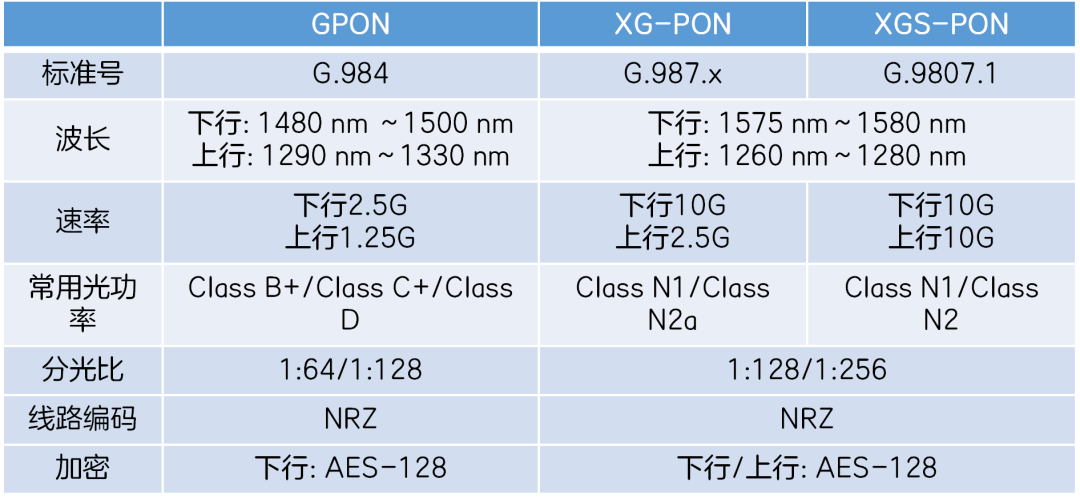
Epilogue
Compared with EPON and GPON, 10G-EPON and XG(S)-PON can better meet the growing needs of customers in terms of transmission bandwidth, optical splitting ratio, efficiency, and security.
However, the development of the PON family from EPON and GPON to 10G-EPON and XG(S)-PON has not ended. PON technology is still developing and improving. How to solve the compatibility problem between XG(S)-PON and GPON? How can PON technology play its role in the 5G era?